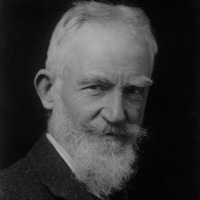Shaw's Dramatic Technique in Major Barbara
Like many propounders of realism in the 19th century theatre, George Bernard Shaw does not divide his play into scenes. He does so because the mode of realism demands uninterrupted continuity in action. Shaw's Major Barbara falls into three acts. In many nineteenth century theatre actions of the plays were kept, as far as possible, compressed within a realistically reminding, lifelike photographic setting.

George B. Shaw (1856-1950)
Shaw has unhesitatingly adopted this technique of not dividing acts of his play into scene Major Barbara belongs to this category. This technique has witnessed its use in the play Major Barbara.
Shaw has employed the second important technique of stage description in minute details. For instances: "Lady Britomart is a woman of fifty or thereabouts, well dressed and yet careless of her dress, well-bred and quite reckless of her breeding, well-mannered and yet appallingly outspoken and indifferent to the opinions of her interlocutors, amiable and yet peremptory ..." This kind of elaborate and detailed description of setting is a must because the play struggled to belong to the category of realism.
Shaw employed the third technique of describing the mood of the character that changes alternately when the character enters into a serious discussion. When a character enters into a serious discussion, some of his old ideas disappear and he/she is forced to accept new ideas. Naturally, his/her moods and attitudes change in the process of lengthy discussion. Therefore, he realized the necessity to describe the attitude and moods of characters as they are about to take part in dialogue, as they are amazed by a new idea, and as they are forced to discard their rotten conservative ideas. The following extract is an example:
Undershaft (triumphantly): Aha Barbara undershaft will be....
Cusins: How do you suppose it got there?
Undershaft: (in towering excitement): It is the undershaft inheritance. I shall hand on my torch to . . .
Cusins: What!
Undershaft: Yes money.
Cusins (Urbanely: trying to bring him down to earth): This is ... Unders haft (with redoubled face): And you?
These expressions exemplify how Shaw was fond of describing the mood of characters as demanded by the protocols of the nineteenth century realism.
Bernard Show called Major Barbara a discussion play. Shaw, as a philosophical playwright, always forwards his radical ideas, however, he is a propagandist and unpalatable, against the conservative ideas of the then English society. To project his ideas with a telling effect Bernard Shaw, chose either character as a mouthpiece. In Major Barbara Shaw chose Andrew Undershaft as his mouthpieces. Through this character Shaw launched his severe attack upon the Salvation Army. In addition, through the medium of his mouthpiece, Andrew undershaft Shaw put forward his painfully pleasing ideas so that his readers are jolted into shocking state.
The use of paradox and irony is another kind of stylistic technique of Shaw. To expose conservative ideas in its hollow and naked form Shaw took the help of the device of paradox. Through ironical device and paradox, Shaw pointed out the limitations of the Salvation Army and flawed vision of Barbara.
Major Barbara Study Center
Major Barbara as a Play of Discussion of Ideas
Barbara as Defeated Idealism in Bernard Shaw's Major Barbara
Andrew Undershaft as a Mouthpiece of Bernard Shaw in Major Barbara
